噪声系数测量
噪声系数的测量方法
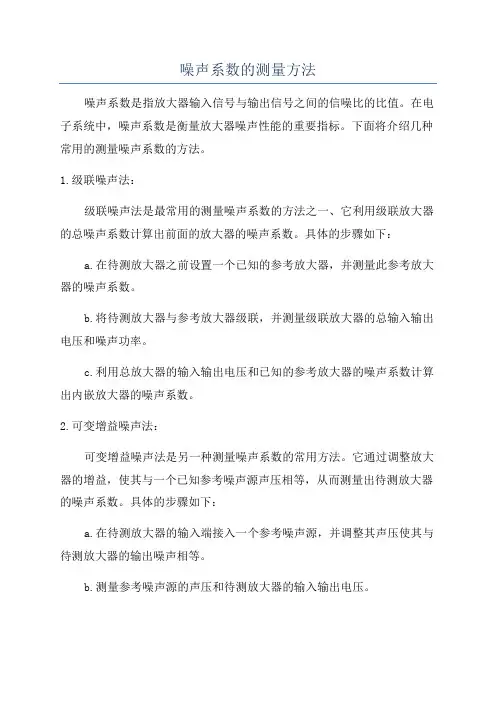
噪声系数的测量方法噪声系数是指放大器输入信号与输出信号之间的信噪比的比值。
在电子系统中,噪声系数是衡量放大器噪声性能的重要指标。
下面将介绍几种常用的测量噪声系数的方法。
1.级联噪声法:级联噪声法是最常用的测量噪声系数的方法之一、它利用级联放大器的总噪声系数计算出前面的放大器的噪声系数。
具体的步骤如下:a.在待测放大器之前设置一个已知的参考放大器,并测量此参考放大器的噪声系数。
b.将待测放大器与参考放大器级联,并测量级联放大器的总输入输出电压和噪声功率。
c.利用总放大器的输入输出电压和已知的参考放大器的噪声系数计算出内嵌放大器的噪声系数。
2.可变增益噪声法:可变增益噪声法是另一种测量噪声系数的常用方法。
它通过调整放大器的增益,使其与一个已知参考噪声源声压相等,从而测量出待测放大器的噪声系数。
具体的步骤如下:a.在待测放大器的输入端接入一个参考噪声源,并调整其声压使其与待测放大器的输出噪声相等。
b.测量参考噪声源的声压和待测放大器的输入输出电压。
c.利用已知的参考噪声源的噪声功率和声压计算出待测放大器的噪声功率和噪声系数。
3.热噪声法:热噪声法是一种常用的测量噪声系数的方法,特别适用于宽频带和高频段的放大器。
热噪声法利用了热噪声在环境温度下的特性,通过直接测量输出噪声电压和环境温度来计算噪声系数。
具体的步骤如下:a.测量放大器的输出噪声电压并记录。
b.测量环境温度并记录。
c.利用热噪声公式计算出放大器的噪声功率。
d.利用输入信号和已知的电阻值计算出放大器的输入信号功率。
e.利用已知的输入信号功率和噪声功率计算出放大器的噪声系数。
除了上述传统的测量方法之外,还有一些新的测量噪声系数的方法正在不断涌现,如矢量分析器法、差分噪声法、噪声大师法等。
这些方法在特定的应用场景下有着更高的测量精度和更广的测量范围。
总结起来,测量噪声系数的常用方法有级联噪声法、可变增益噪声法、热噪声法等。
根据不同的应用场景和要求,选择合适的方法来测量噪声系数,有助于评估放大器的噪声性能,进而提高信号传输的质量。
《噪声系数和测量》课件

设置测量参数:频率、功率、温度等
记录数据:记录测量得到的噪声系数、频率、功率等数据
连接测量仪器:将信号源、功率计、噪声系数分析仪等连接起来
分析数据:分析噪声系数与频率、功率的关系,得出结论
测量结果分析
噪声系数:衡量信号传输过程中噪声的影响程度
测量方法:使用噪声系数测量仪,测量信号的输入和输出噪声
测量结果:噪声系值,表示信号传输过程中噪声的影响程度
噪声系数的应用:在通信、电子、声学等领域都有广泛的应用
噪声系数的计算公式:噪声系数=输出信号功率/输入信号功率
噪声系数的测量
测量原理
噪声系数的定义:描述信号传输过程中噪声增加的程度
测量步骤:首先设置测量参数,然后输入信号,最后读取输出信号并计算噪声系数
注意事项:测量过程中要保证信号的稳定性和准确性,避免干扰因素影响测量结果
添加标题
添加标题
噪声系数测量设备的智能化和自动化
噪声系数测量技术的不断发展和完善
噪声系数测量标准的不断提高和统一
噪声系数测量技术的应用领域不断扩展,如航空航天、电子通信等
展望
噪声系数测量技术的发展:更加精确、快速、便捷
噪声系数测量设备的发展趋势:智能化、小型化、便携化
噪声系数测量在环保领域的应用:更加广泛,更加重要
测量方法:使用噪声系数测量仪,通过测量输入信号和输出信号的功率比来计算噪声系数
测量设备
声级计:测量噪声的强度和频率
频谱分析仪:分析噪声的频率成分
噪声源定位仪:确定噪声源的位置
噪声剂量计:测量噪声暴露剂量
测量步骤
准备测量仪器:噪声系数分析仪、信号源、功率计等
启动测量:启动信号源,调整功率,观察噪声系数分析仪的读数
噪声系数噪声参数测量-essun
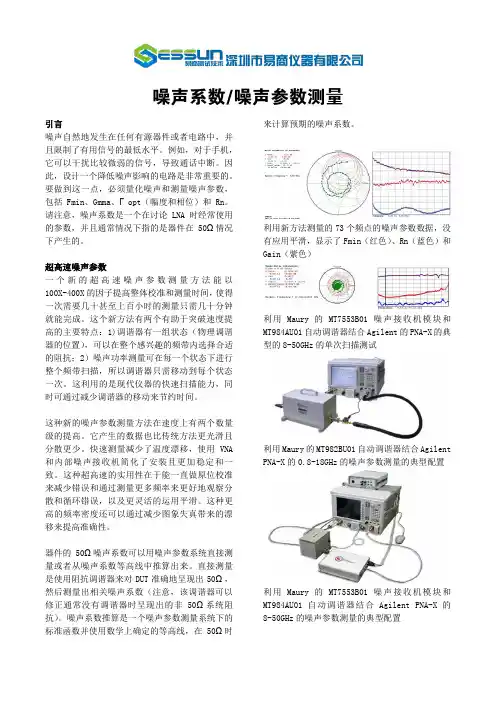
噪声系数/噪声参数测量引言噪声自然地发生在任何有源器件或者电路中,并且限制了有用信号的最低水平。
例如,对于手机,它可以干扰比较微弱的信号,导致通话中断。
因此,设计一个降低噪声影响的电路是非常重要的。
要做到这一点,必须量化噪声和测量噪声参数,包括Fmin、Gmma、Γopt(幅度和相位)和Rn。
请注意,噪声系数是一个在讨论LNA时经常使用的参数,并且通常情况下指的是器件在50Ω情况下产生的。
超高速噪声参数一个新的超高速噪声参数测量方法能以100X-400X的因子提高整体校准和测量时间,使得一次需要几十甚至上百小时的测量只需几十分钟就能完成。
这个新方法有两个有助于突破速度提高的主要特点:1)调谐器有一组状态(物理调谐器的位置),可以在整个感兴趣的频带内选择合适的阻抗;2)噪声功率测量可在每一个状态下进行整个频带扫描,所以调谐器只需移动到每个状态一次。
这利用的是现代仪器的快速扫描能力,同时可通过减少调谐器的移动来节约时间。
这种新的噪声参数测量方法在速度上有两个数量级的提高。
它产生的数据也比传统方法更光滑且分散更少。
快速测量减少了温度漂移,使用VNA 和内部噪声接收机简化了安装且更加稳定和一致。
这种超高速的实用性在于能一直做原位校准来减少错误和通过测量更多频率来更好地观察分散和循环错误,以及更灵活的运用平滑。
这种更高的频率密度还可以通过减少图象失真带来的漂移来提高准确性。
器件的50Ω噪声系数可以用噪声参数系统直接测量或者从噪声系数等高线中推算出来。
直接测量是使用阻抗调谐器来对DUT准确地呈现出50Ω,然后测量出相关噪声系数(注意,该调谐器可以修正通常没有调谐器时呈现出的非50Ω系统阻抗)。
噪声系数推算是一个噪声参数测量系统下的标准函数并使用数学上确定的等高线,在50Ω时来计算预期的噪声系数。
利用新方法测量的73个频点的噪声参数数据,没有应用平滑,显示了Fmin(红色)、Rn(蓝色)和Gain(紫色)利用Maury的MT7553B01噪声接收机模块和MT984AU01自动调谐器结合Agilent的PNA-X的典型的8-50GHz的单次扫描测试利用Maury的MT982BU01自动调谐器结合Agilent PNA-X的0.8-18GHz的噪声参数测量的典型配置利用Maury的MT7553B01噪声接收机模块和MT984AU01自动调谐器结合Agilent PNA-X的8-50GHz的噪声参数测量的典型配置。
噪声系数的三种测量方法及对比
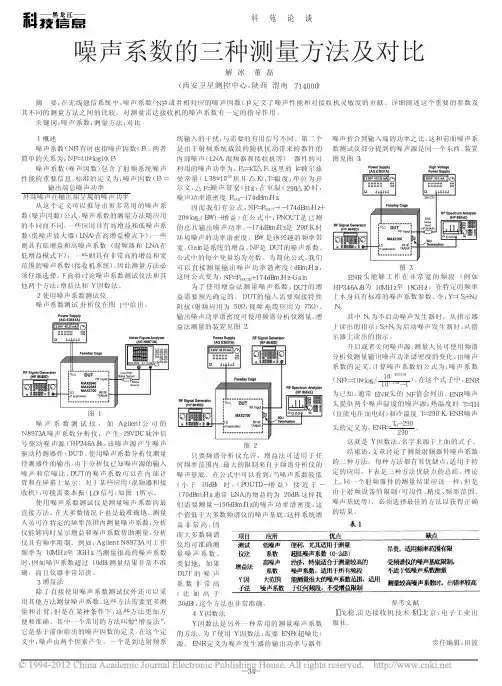
。
图2 只要频谱分析仪允许, 增益法可适用于任 何频率范围内。最大的限制来自于频谱分析仪的 噪声基底。在公式中可以看到, 当噪声系数较低 ( 小 于 10dB) 时 ,( POUTD- 增 益 ) 接 近 于 - 170dBm/Hz, 通常 LNA 的增益约为 20dB。这样我 们需要测量- 150dBm/Hz 的噪声功率谱密度, 这 个值低于大多数频谱仪的噪声基底。这样系统增
这就是 Y 因数法, 名字来源于上面的式子。 结束语: 文章讨论了测量射频器件噪声系数 的三种方法。每种方法都有其优缺点, 适用于特 定的应用。下表是三种方法优缺点的总结。理论 上, 同一个射频器件的测量结果应该一样, 但是 由于射频设备的限制( 可用性、精度、频率范围、 噪声基底等) , 必须选择最佳的方法以获得正确 的结果。
关键词: 噪声系数; 测量方法; 对比
1 概述 噪声系数( NF) 有时也指噪声因数( F) 。两者 简单的关系为: NF=10*log10( F) 噪声系数( 噪声因数) 包含了射频系统噪声 性能的重要信息, 标准的定义为: 噪声因数( F) =
输出端总噪声功率 外部噪声在输出端呈现的噪声功率
从这个定义可以推导出很多常用的噪声系 数( 噪声因数) 公式。噪声系数的测量方法随应用 的不同而不同。一些应用具有高增益和低噪声系 数( 低噪声放大器( LNA) 在高增益模式下) , 一些 则具有低增益和高噪声系数 ( 混频器和 LNA 在 低增益模式下) , 一些则具有非常高的增益和宽 范围的噪声系数( 接收机系统) 。因此测量方法必 须仔细选择。下面将讨论噪声系数测试仪法和其 他两个方法: 增益法和 Y 因数法。
益非常高, 因
表1
而大多数频谱
仪均可准确测
量噪声系数。
噪声系数测量手册1:噪声系数定义及测试方法
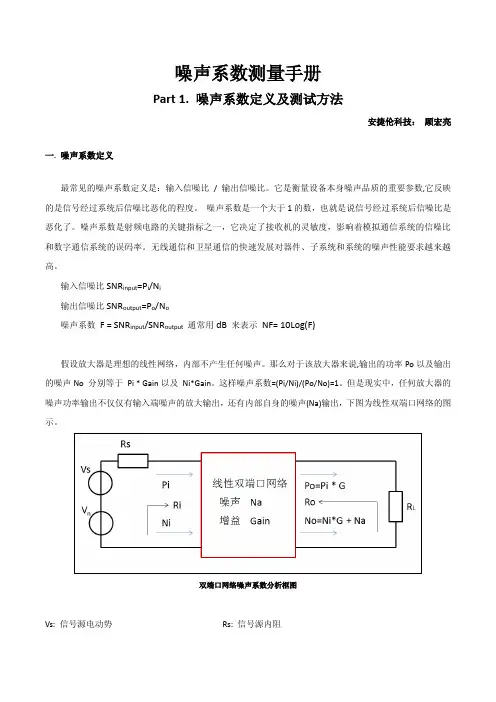
噪声系数测量手册Part 1. 噪声系数定义及测试方法安捷伦科技:顾宏亮一.噪声系数定义最常见的噪声系数定义是:输入信噪比/ 输出信噪比。
它是衡量设备本身噪声品质的重要参数,它反映的是信号经过系统后信噪比恶化的程度。
噪声系数是一个大于1的数,也就是说信号经过系统后信噪比是恶化了。
噪声系数是射频电路的关键指标之一,它决定了接收机的灵敏度,影响着模拟通信系统的信噪比和数字通信系统的误码率。
无线通信和卫星通信的快速发展对器件、子系统和系统的噪声性能要求越来越高。
输入信噪比SNR input=P i/N i输出信噪比SNR output=P o/N o噪声系数F =SNR input/SNR output通常用dB来表示NF= 10Log(F)假设放大器是理想的线性网络,内部不产生任何噪声。
那么对于该放大器来说,输出的功率Po以及输出的噪声No 分别等于Pi * Gain以及Ni*Gain。
这样噪声系数=(Pi/Ni)/(Po/No)=1。
但是现实中,任何放大器的噪声功率输出不仅仅有输入端噪声的放大输出,还有内部自身的噪声(Na)输出,下图为线性双端口网络的图示。
双端口网络噪声系数分析框图Vs: 信号源电动势Rs: 信号源内阻Ri: 双端口网络输入阻抗R L: 负载阻抗Ni: 输入噪声功率Pi: 输入信号功率No: 输出噪声功率Po: 输出信号功率Vn: 该信号源内阻Rs的等效噪声电压Ro: 双端口网络输出阻抗输出噪声功率: N o = N i * Gain + N a ; P o=P i * Gain噪声系数= (P i * N o)/(N i* P o) = (N i * Gain + N a) /(N i * Gain)= 1 + Na/(N i * Gain) > 1根据IEEE的噪声系数定义:The noise factor, at a specified input frequency, is defined as the ratio of (1) the total noise power per unit bandwidth available at the output port when noise temperature of the input termination is standard (290 K) to (2) that portion of (1) engendered at the input frequency by the input termination.”a.输入噪声被定义成负载在温度为290K下产生的噪声。
频谱仪测噪声系数测试方法
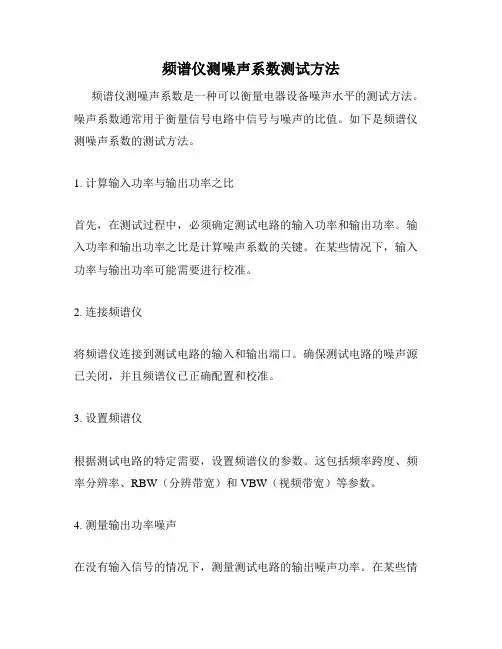
频谱仪测噪声系数测试方法
频谱仪测噪声系数是一种可以衡量电器设备噪声水平的测试方法。
噪声系数通常用于衡量信号电路中信号与噪声的比值。
如下是频谱仪测噪声系数的测试方法。
1. 计算输入功率与输出功率之比
首先,在测试过程中,必须确定测试电路的输入功率和输出功率。
输入功率和输出功率之比是计算噪声系数的关键。
在某些情况下,输入功率与输出功率可能需要进行校准。
2. 连接频谱仪
将频谱仪连接到测试电路的输入和输出端口。
确保测试电路的噪声源已关闭,并且频谱仪已正确配置和校准。
3. 设置频谱仪
根据测试电路的特定需要,设置频谱仪的参数。
这包括频率跨度、频率分辨率、RBW(分辨带宽)和VBW(视频带宽)等参数。
4. 测量输出功率噪声
在没有输入信号的情况下,测量测试电路的输出噪声功率。
在某些情
况下,需要在输出端口使用负载以测量噪声功率。
5. 注入输入电信号
在测试电路的输入端注入一个准确的电信号,并测量频谱仪的输出。
将输出功率与测量输出噪声功率的结果进行比较,可以计算出噪声系数。
6. 计算噪声系数
通过将输出功率与测量输出噪声功率之比除以输入功率与输出功率之比,可以计算出噪声系数。
通常,噪声系数表示为dB。
在完成测试后,可以对测试结果进行数据分析和报告编制。
这样,测试人员可以将测试结果以可读的形式呈现给客户或其他利益相关者。
噪声系数的含义和测量方法
噪声系数的含义和测量方法
噪声系数是指信号的输入与输出之间的不匹配程度。
它描述了信号传
输中由于不同因素引入的噪声与理论信号的误差比例。
噪声系数越低,表
示信号传输的质量越好。
测量噪声系数的方法主要有两种:器件法和级联法。
1.器件法:这种方法通过对测试样品进行直接测试来测量噪声系数。
测试过程中,利用馈电器件法将器件与参考元件相比较。
参考元件是已知
噪声性能的稳定器件,通常是一种电阻。
通过将被测器件和参考电阻器件
进行比较,可以计算出被测器件的噪声系数。
测量噪声系数时需要注意以下几点:
1.测试环境的干扰要尽可能减少,如尽量避免有其他电磁干扰源的存在。
2.测试过程中需要采用高灵敏度的仪器和设备进行测量,以保证准确性。
3.测量结果可能受到温度、频率等因素的影响,需要进行相应的修正。
4.测量时需要注意信号与噪声的区分,以避免噪声信号被错误地计入
信号中。
噪声系数的大小与信号传输过程中的损耗和噪声有关。
信号传输过程
中会受到各种因素的影响,如电阻、电感、电容、温度等。
这些因素会引
入噪声,导致信号损失和畸变。
噪声系数表示噪声引入的程度,即信号损
失与噪声之间的比值。
测量噪声系数的目的是为了评估信号传输的质量,找出信号传输过程
中引入的噪声和损耗。
这样可以针对噪声源采取相应的优化和改善措施,
提高信号传输系统的性能。
对于需要高质量信号的应用领域,如通信系统、射频系统等,噪声系数的测量和优化具有重要的意义。
noise figure 噪声系数
noise figure 噪声系数噪声是指信号处理系统中不希望的杂音或干扰。
在设计和分析接收机、放大器等系统时,噪声成为了不可或缺的因素。
而噪声系数(Noise Figure)则是表示信号处理器件增益中采集到的噪声功率与采集到的信号功率之比的一个重要参数。
本文将围绕“噪声系数”这一主题,对它的作用、计算和测量等方面进行阐述。
一、噪声系数的作用噪声系数是一个直接反映接收机、放大器等电子器件噪声性能好坏的参数。
通常情况下,设一个器件的输入信号功率为Pin,则它的输出功率为Pout。
而器件内部存在一个噪声功率Pn,噪声系数就可以用如下公式来表示:NF=(Signal-to-Noise Ratio)out / (Signal-to-Noise Ratio)in其中,“Signal-to-Noise Ratio”in表示输入信号功率与输入噪声功率的比值,“Signal-to-Noise Ratio”out 表示输出信号功率与输出噪声功率的比值。
该公式表明了在输入信号功率相同的情况下,输出噪声功率越小,噪声系数越小。
当噪声系数越小的时候,系统就越容易实现高精度和高灵敏度的信号接收和处理。
因此,噪声系数是衡量接收机/放大器等电子器件性能好坏的关键性能指标之一。
二、噪声系数的计算计算噪声系数的方法有两种,一种是使用实际的噪声功率和信号功率值计算。
另一种方法则是使用噪声指数(Noise Figure Index)来计算,而噪声指数它的公式为:NI=10 log10(1+NF)噪声指数是指把噪声系数的负对数乘以10以及再加上1后所得到的值,单位通常为dB。
噪声系数和噪声指数的转换是通过取10的幂函数来实现的。
三、噪声系数的测量噪声系数的测量需要通过噪声测试仪进行。
噪声测试仪能够将器件输入端的噪声功率和输出端的噪声功率进行测量,从而得到噪声系数的值。
通常,噪声测试仪的输入端是通过噪声发生器来产生随机噪声信号,输出端连接待测试的器件。
噪声系数测量方法
噪声系数测量的三种方法摘要:本文介绍了测量噪声系数的三种方法:增益法、Y系数法和噪声系数测试仪法。
这三种方法的比较以表格的形式给出。
前言在无线通信系统中,噪声系数(NF)或者相对应的噪声因数(F)定义了噪声性能和对接收机灵敏度的贡献。
本篇应用笔记详细阐述这个重要的参数及其不同的测量方法。
噪声指数和噪声系数噪声系数(NF)有时也指噪声因数(F)。
两者简单的关系为:NF = 10 * log10 (F)定义噪声系数(噪声因数)包含了射频系统噪声性能的重要信息,标准的定义为:式1从这个定义可以推导出很多常用的噪声系数(噪声因数)公式。
下表为典型的射频系统噪声系数:Category MAXIMProductsNoise Figure*Applications Operating Frequency System GainLNA MAX2640Cellular, ISM400MHz ~ 1500MHzLNA MAX2645HG: WLL~ HG: LG: WLL~ LG:Mixer MAX2684LMDS, WLL~ 1dBMixer MAX998212dB Cellular, GSM825MHz ~ 915MHzReceiverSystemMAX2700~ 19dB PCS, WLL~ < 80dB* HG = 高增益模式,LG = 低增益模式噪声系数的测量方法随应用的不同而不同。
从上表可看出,一些应用具有高增益和低噪声系数(低噪声放大器(LNA)在高增益模式下),一些则具有低增益和高噪声系数(混频器和LNA在低增益模式下),一些则具有非常高的增益和宽范围的噪声系数(接收机系统)。
因此测量方法必须仔细选择。
本文中将讨论噪声系数测试仪法和其他两个方法:增益法和Y系数法。
使用噪声系数测试仪噪声系数测试/分析仪在图1种给出。
图1.噪声系数测试仪,如Agilent的N8973A噪声系数分析仪,产生28VDC脉冲信号驱动噪声源(HP346A/B),该噪声源产生噪声驱动待测器件(DUT)。
噪声系数测量的三种方法
噪声系数测量的三种方法噪声系数是指在电子设备或电路中测量的信号质量衰减与理想条件下信号质量衰减之间的比值。
噪声系数越低,表示设备或电路产生的噪声越少,信号质量损失越小。
噪声系数的测量对于评估设备性能和优化电路设计至关重要。
下面介绍三种常用的测量噪声系数的方法。
1. 热噪声法(Hot Noise)热噪声法是一种直接测量噪声系数的方法,常用于微波器件和射频(RF)电路的噪声性能测量。
该方法的基本原理是通过在待测器件或电路输入端引入一个加热元件,使其在高温状态下工作,将加热元件所产生的热噪声和待测器件的输出噪声进行对比测量。
具体步骤如下:-在待测器件或电路的输入端插入一个短截线,将其与噪声发生器连接。
-在待测器件的输出端接上一个噪声功率测量装置。
-通过调节噪声发生器的输出功率,使得待测器件的输出功率与加热元件产生的热噪声功率相等。
-测量并记录加热元件的功率和待测器件的输出功率。
通过以上步骤可以得到待测器件的热噪声功率和输出功率,从而计算出噪声系数。
2. 对比法(Noise Figure Meter)对比法是一种间接测量噪声系数的方法,适用于比较不同器件或电路的噪声性能。
该方法通过测量两个不同器件或电路的输出噪声功率和输入信号功率的比值,进而计算出噪声系数。
具体步骤如下:-将待测器件和参考器件分别与噪声源相连。
-将两个器件的输出端与噪声功率测量装置相连。
-分别测量并记录待测器件和参考器件的输出噪声功率和输入信号功率。
通过以上步骤可以得到待测器件和参考器件的输出噪声功率和输入信号功率,从而计算出噪声系数。
3. 增益-噪声法(Gain-Noise Method)增益-噪声法是一种常用的测量噪声系数的方法,适用于放大器和无源器件的噪声性能测量。
该方法通过测量待测器件的增益和噪声指标,进而计算出噪声系数。
具体步骤如下:-将待测器件的输入端与信号源相连,输出端与噪声功率测量装置相连。
-测量并记录待测器件的输出噪声功率和输入信号功率。
- 1、下载文档前请自行甄别文档内容的完整性,平台不提供额外的编辑、内容补充、找答案等附加服务。
- 2、"仅部分预览"的文档,不可在线预览部分如存在完整性等问题,可反馈申请退款(可完整预览的文档不适用该条件!)。
- 3、如文档侵犯您的权益,请联系客服反馈,我们会尽快为您处理(人工客服工作时间:9:00-18:30)。
Technical data is subject to change. Copyright@2004 AgilentFundamentalnoise conceptsHow do wemakemeasurements?What DUTscan wemeasure?What influencesthe measurementuncertainty?What is Noise Figure ?NoiseOutNoise inMeasurement bandwidth=25MHza) C/N at amplifier input b) C/N at amplifier outputNinNoutGa RsTwo examples of Noise FigureExample 1: In a receiver, the LNA is connected to an antenna which points to earth’s atmosphere (290K) and the LNA has 3dB NF and 10dB gain. Noise power at LNA output is: -174+10+3=-161dBm/Hz Example 2: In a transmitter the modulator noise floor is -140dBm/Hz. The modulator output is amplifier by a linear amp with 3dB NF and 10dB gain. Noise power at amplifier output is: -140+10+3=-127dBm/Hz-140dBm corresponds to a noise source with a temperature 700 million K, i.e. DUT input is not Standard Temperature and Example 2 is wrongJust to emphasize this point, noise figure only represents the noise added to the input noise referred to the DUT output when the noise into the device is thermal noise at the standard temperature. So the first example here is correct. In the second example, the noise going into the device is much higher and therefore the noise figure of the amplifier cannot be added to the noise out of the DUT from the modulator. In reality if the noise of the amplifier is only 3dB then it will add practically no noise to that generated by the modulator.11An Alternative Way to Describe Noise Figure: Effective Input Noise TemperatureNinNout = Na + kTB GaRsOutput PowerGa , NaSlope=kBGac isti ter c arais NoC ree eFhNa -Te Te Source Temperature (K)Let’s now plot the output noise power as a function of the temperature of the noise source. In the equation for Nout I have substituted Nin for kTB where T now varies from absolute zero upwards. It’s a linear curve as we are dealing with very low power levels so all devices are operating in their linear regions. Actually the line is a very standard ‘y=mx+C’. M is the gradient in this case kBGa and c is the point at which the curve intersects the y axis. C is equal to Na. What you can say at T=0 is that no power at the device output comes from the noise source. All the output power at this point is generated within the DUT. This gives us another figure of merit for describing the noise performance of active devices. If you look at the graph I have drawn the characteristic of a noise free device. If you transpose the added noise Na through this line on to the x axis you arrive at Te, the effective input noise temperature. When you multiply Te by the gain bandwidth product of the device you get the amount of noise added. It’s a useful figure of merit because it is independent of the device gain (unlike Na).12Effective Noise Temperature relation to NFNa + kToBG F= kToBG = Therefore Te = (F-1) . To Na Assume Na = 0 Ts Te kGBTe + kGBTo kBGTo = Te + To ToTsGain GGain GWhat is Te if the NF is 3dB?13Te or NF: which should I use?Use either - they are completely interchangeable typically NF for terrestrial and Te for space NF referenced to 290K - not appropriate in space If Te used in terrestrial systems and the temperatures can be large (10dB=2610K) Te is easier to characterize graphically14Friis Cascade FormulaGa1Ga2F1 F2-1 Ga1F2Σ FN+1 = Σ Fn + Fn+1 - 1 ΣGNF12 = F1 +Where Σ Fn is cumulative NF up to nth stage and Σ FN+1 is cumulative NF up to (n+1)th stageNoise figure can be used for much more than just characterizing a single stage. If you know the noise figure and gain of each stage you can calculate the noise figure of a cascade of devices. This equation is known as the cascade formula or Friis formula. F12 is the noise figure of the 2 stage system. G1 is the gain of the first stage, F1 is the NF of the first stage and F2 is the NF of the second stage. The formula clearly shows why you must put your best noise figure devices at the front of the chain. Also the higher the gain of the first stage, the less the noise figure contribution from subsequent stages.15Receiver Modelling using Excelstage 1 stage 2 stage 3 stage 4 TOTAL NF AMP1 2.00 14.00 2.00 14.00 AMP1 2.00 9.00 AMP2 4.00 16.00 2.00 9.00 AMP2 4.00 16.00 2.16 30.00 AMP3 5.00 20.00 2.49 25.00 AMP3 5.00 20.00 2.17 50.00 AMP4 10.00 30.00 2.51 45.00 AMP4 10.00 30.00 2.171NF gain cummulative NF cummulative gain1 22 3 4NF gain cummulative NF cummulative gainstage 1stage 2stage 3stage 4TOTAL NF 2.51NF gain cummulative NF cummulative gainAMP1 4.00 16.00 4.00 16.00 LOSS1 4.00 -4.00 4.00 -4.00AMP2 2.00 14.00 4.03 30.00 AMP1 2.00 14.00 6.00 10.00AMP3 5.00 20.00 4.03 50.00 AMP2 4.00 16.00 6.16 26.00AMP4 10.00 30.00 4.03NF gain cummulative NF cummulative gainAMP3 5.00 20.00 6.1710*LOG((10^(F22/10))+(10^(G20/10)-1)/10^(F23/10))Here is an example of how useful the cascade formula is in the estimation of receiver sensitivity. I’ve used EXCEL to illustrate the example as EXCEL is a very simple and powerful way of performing linear calculations. Both examples have four system components. In the first one I have my low noise amplifier at the front followed by a linear gain block followed by 2 further gain stages. My best noise figure device is placed first as it will dominate the noise figure performance of the system. You can see that the overall noise figure performance is little more than the noise figure of the first stage. The second example is identical, except for the fact that the LNA has lower gain. This mean that the noise contribution of the following stages is more noticeable. The point to make here is that the noise figure of a device is important - but so is its gain. In the third one I have swapped the first two amplifiers around and you can see the difference his has made to the overall noise figure - although the cumulative gain is the same the noise figure is dominated by the first - and now poorer - noise figure performance. The last example is similar to the very fist one except that now4 dB of loss have been introduced. This is common in receiver systems and could represent the cabling between an antenna and the LNA or a front end duplexer. The noise figure of a passive lossy device is equal to its loss. Overall you just add front end losses to the system noise figure to get the overall noise figure The noise figure of a passive device can be seen to be same the magnitude of the insertion gain. For example, a 6dB attenuator will have a noise figure of +6dB, but an insertion gain of -6dB. This can also be seen from standard calculation as well. As an example : if Noise Factor = N out / Gain x N in, and if Noise_out = Noise_in for this case, and Gain = 1/4 then Noise Factor is 4 and the noise figure is the log of this at + 6dB I’ve shown the cascade equation in slightly modified form. This is what you would type into excel. Fn is the cumulative noise figure up to the nth stage and sigma Ga1 is the cumlative gain.16Why do we measure Noise Figure? Example...Transmitter: ERP Path Losses Rx Ant. Gain Power to Rx Receiver: Noise Floor@290K Noise in 100 MHz BW Receiver NF Rx Sensitivity -174 dBm/Hz +80 dB +5 dB -89 dBm + 55 dBm -200 dB 60 dB -85 dBmERP = +55 dBmPatC/N= 4 dB:sses h Lo200dBChoices to increase Margin by 3dB 1. Double transmitter power 2. Increase gain of antennas by 3dB 3. Lower the receiver noise figure by 3dBReceiver NF: 5dB Bandwidth: 100MHz Antenna Gain: +60dBPower to Antenna: +40dBm Frequency: 12GHz Antenna Gain: +15dBHere is an example of why we need to know the noise figure of a device. In this example, we have a satellite that transmits with an effective radiated power of +55dBm, and is transmitted through a path loss, of +200dB, to a receive antenna with gain of 60dB. The signal power to the receiver is -85dBm. The receiver sensitivity is calculated here using kTB is at -174dBm /Hz and the noise power in a 100 MHz bandwidth you add 80dB. The noise figure of the complete receiver is +5dB. So the receiver noise floor is at -89dBm. S we currently have a 4dB carrier to noise ratio in our 100MHz channel. If we wanted to double the link margin to get improved receiver reliability, then we could double the transmitter power. This would cost millions of dollars in terms of increased payload and /or higher rated, more expensive components and more challenging engineering issues. Another way is to increase the gain of the receiver. This would cost millions in terms of size and mechanical engineering, and the debates over local environmental issues and planning permissions. While lowering the Noise Figure of the front end would be a fraction of this, and is the more attractive economically. Noise figure is a $$$ figure.17What Noise Figure is Not…Not a figure of merit for different modulation techniques use BER instead Not a quality factor for one port networks e.g. synthesizers, power supplies Not a useful quality factor for high power stages use transmitter testerWe have discussed what noise figure is. It is maybe usefully to briefly describe what noise figure is not. It does not give any indication of the efficiency of the modulation scheme chosen. In digital receivers this is done by BER. BER and noise figure have a nonlinear relationship where as you gradually decrease the signal to noise ratio you will suddenly see a rise in BER as 1’s and 0’s become confused. Noise figure is a two port figure of merit. It does not describe one port networks such as terminations or oscillators. Oscillators do generate noise and will affect the sensitivity of receivers but noise figure is not a means of measuring oscillator quality. Here phase noise measurements would be more appropriate. High power stages imply nonlinearity and noise figure is a function of strictly linear systems. Also high power stages implies high levels of input noise, so the added noise of the of the high power stage is likely to be very small - remember noise figure is defined where the input power has an effective temperature of 290K.18Summary of Noise FundamentalsThe Origins of Noise Signal to Noise ratio Definition of Noise Figure Effective Noise Temperature Friis Cascade Formula Using Excel in Rx modeling System Sensitivity Calculation19How do we make measurements?Fundamental noise conceptsHow do we make measurements?What DUTs can we measure?What influences the measurement uncertainty?Now that we have seen the basic concepts of noise, let’ now look at how we make those measurements.20Nout = Na + kTBGaGa , NaRsNout = Nh or Nc RsXXX YYY ZZZ AAABBBCCC......ENR dBFrequency Excess Noise Ratio, ENR (dB) = 10 Log 10( T h -290)290Fundamentalnoise conceptsHow do wemakemeasurements?What DUTscan wemeasure?What influencesthe measurementuncertainty?Fundamentalnoise conceptsHow do wemakemeasurements?What DUTscan wemeasure?What influencesthe measurementuncertainty?ResultsN8970 Series Noise Figure Analyzers•Fast, accurate and repeatable noise figure measurements up to 26.5 GHz (higher frequency also possible)•Simultaneous noise figure and gain measurements.•Compact and portablePSA Series Spectrum Analyzers •Industry’s highest performance spectrum analyer•Now with Noise Figure personality.Noise Sources•Up to 26.5 GHz and 15dB ENR •Calibration data is automatically down-loaded from the SNS series sources to noise figure analyzer.Technical data is subject to change. Copyright@2004 Agilent。
